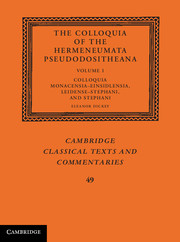Book contents
- Frontmatter
- Contents
- Plates
- Figures
- Acknowledgments
- Part One Introduction
- Part Two Colloquia Monacensia–Einsidlensia
- Introduction to the Colloquia Monacensia–Einsidlensia
- Text, Translation, and Critical Apparatus
- Commentary
- Part Three Colloquium Leidense–Stephani
- Commentary
- Part Four Colloquium Stephani
- Commentary
- Appendix
- Bibliography
- Concordances
Introduction to the Colloquia Monacensia–Einsidlensia
from Part Two - Colloquia Monacensia–Einsidlensia
Published online by Cambridge University Press: 05 May 2013
- Frontmatter
- Contents
- Plates
- Figures
- Acknowledgments
- Part One Introduction
- Part Two Colloquia Monacensia–Einsidlensia
- Introduction to the Colloquia Monacensia–Einsidlensia
- Text, Translation, and Critical Apparatus
- Commentary
- Part Three Colloquium Leidense–Stephani
- Commentary
- Part Four Colloquium Stephani
- Commentary
- Appendix
- Bibliography
- Concordances
Summary
This piece is often viewed as two separate entities because the two main branches of its manuscript tradition differ from one another significantly. Unable to reconcile the two successfully, in the main body of his work Goetz (1892) printed them as two separate texts, Monacensia and Einsidlensia, each with its own apparatus. In the appendix containing restored versions of the various colloquia, however, Goetz provided only one version of this piece. Although entitled ‘Colloquia Monacensia’, that version is in fact a combination of the two, based on an edition by Karl Krumbacher (1891) that drew heavily on sources from the Einsidlensia family. Goetz’s failure to explain the nature of this restored version or provide an apparatus for it has often confused readers into thinking that readings drawn from the Einsidlensia version were either attested in the Monacensia manuscripts or invented by Goetz.
The Monacensia or M version is the older and more important branch of the tradition, attested from the twelfth century onwards. The Einsidlensia or E version is attested only from the fifteenth century; the later date makes it in many ways less useful for restoring the original text, but nevertheless it cannot be dispensed with. The M version has its Greek entirely in a transliterated and then corrupted version (apart from one very late manuscript in which a highly corrupt version of that transliteration has been transliterated back into Greek script), and the untransliterated Greek of E is essential for making sense of the M version.
- Type
- Chapter
- Information
- The Colloquia of the Hermeneumata Pseudodositheana , pp. 59 - 98Publisher: Cambridge University PressPrint publication year: 2012



